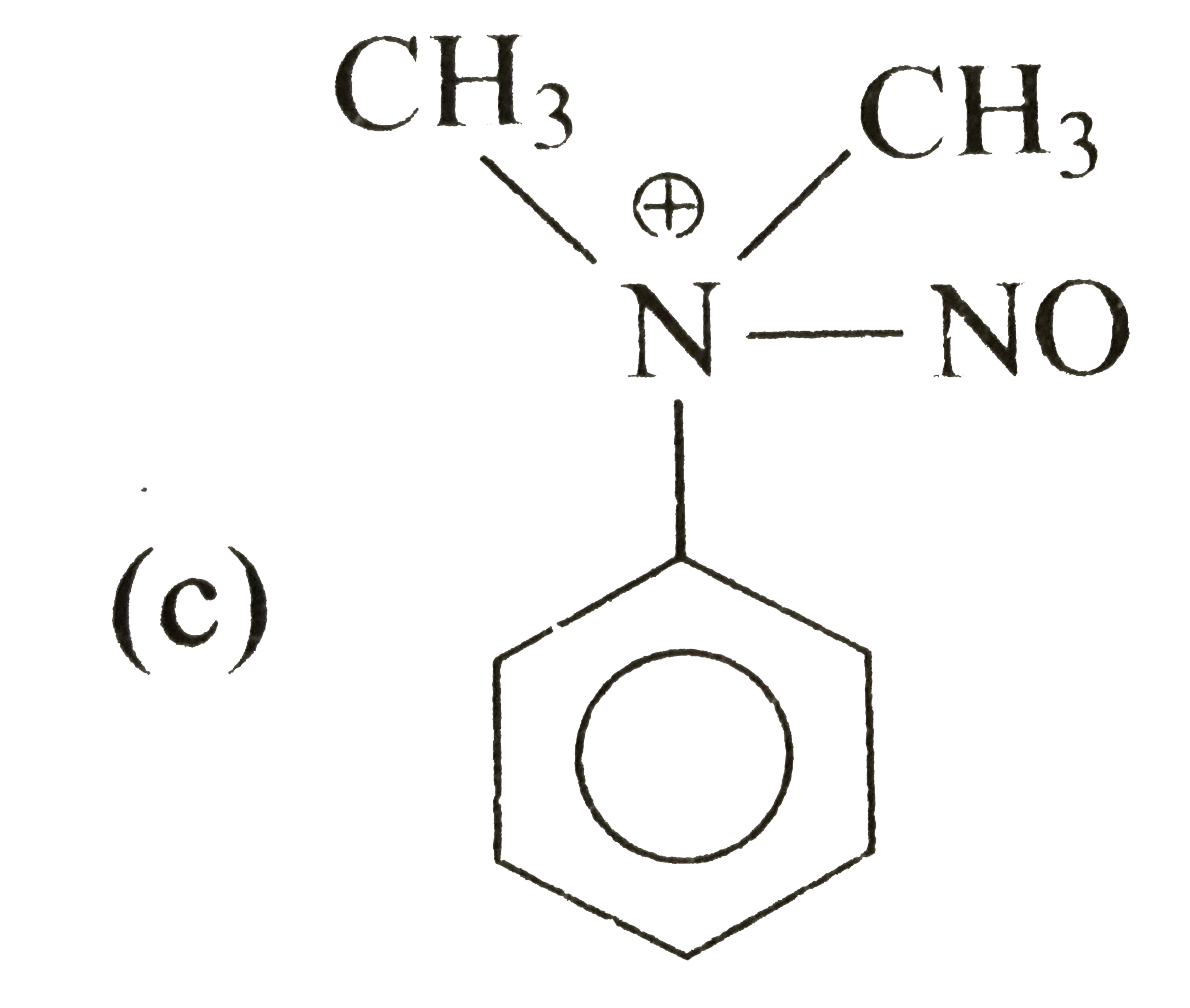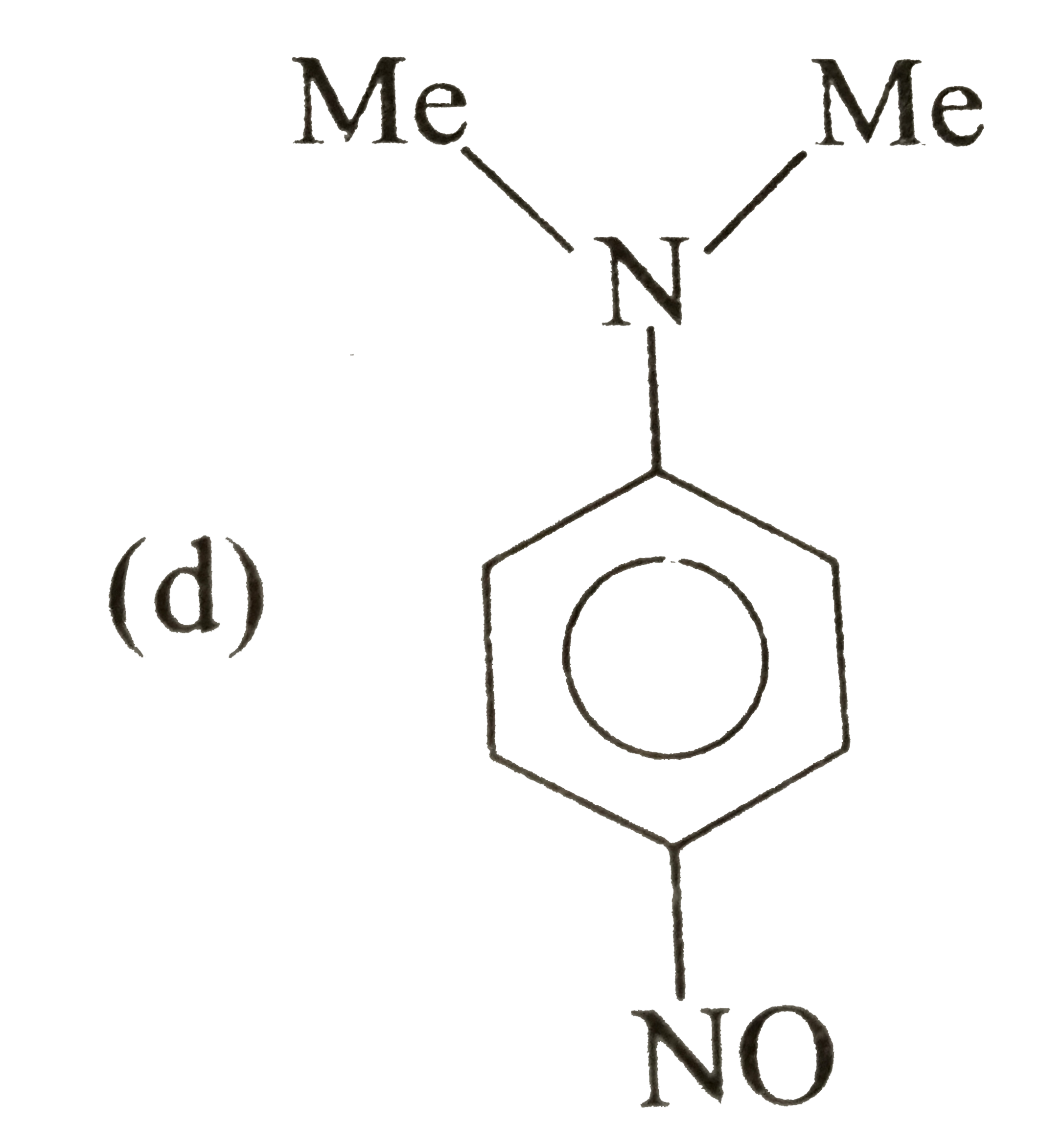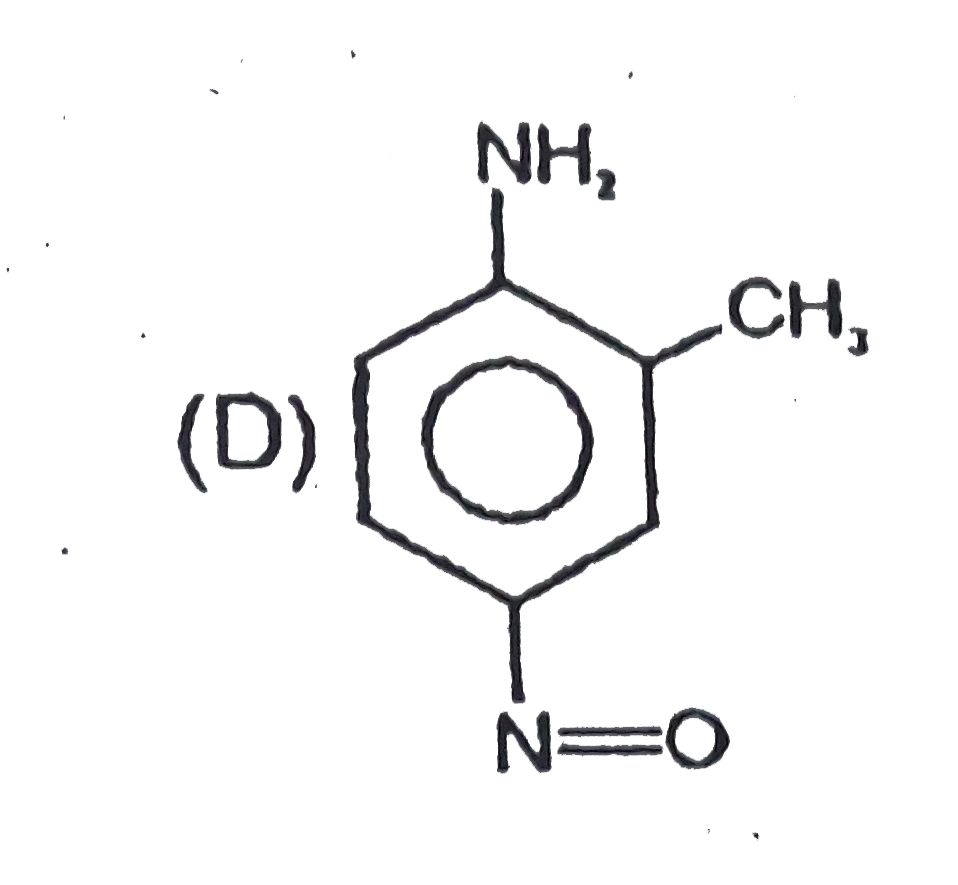N,N- Dimethyl aniline react with NaNO2 and dilute HCl at 0−5∘C to from :




The correct Answer is:D
To solve the problem of what product is formed when N,N-Dimethyl aniline reacts with NaNO2 and dilute HCl at 0-5°C, we can follow these steps:
Step 1: Understand the Reactants
N,N-Dimethyl aniline is an aromatic amine with the structure:
- A benzene ring (C6H5)
- An amino group (–NH) attached to the ring, which is further substituted with two methyl groups (–CH3).
Step 2: Reaction with NaNO2 and HCl
When N,N-Dimethyl aniline is treated with sodium nitrite (NaNO2) and dilute hydrochloric acid (HCl), a nitrous acid (HNO2) is formed in situ. The reaction can be summarized as:
NaNO2+HCl→HNO2+NaCl
Step 3: Formation of Nitrosonium Ion
Nitrous acid (HNO2) can decompose to form a nitrosonium ion (NO^+), which is a powerful electrophile:
HNO2→NO++H2O
Step 4: Electrophilic Substitution
N,N-Dimethyl aniline is an ortho-para directing group due to the electron-donating nature of the nitrogen atom (which has a lone pair). The nitrosonium ion will preferentially attack the ortho or para positions on the benzene ring.
Step 5: Consider Steric Hindrance
Although both ortho and para positions are activated, steric hindrance from the two methyl groups on the nitrogen makes the para position more favorable for substitution. Therefore, the nitrosonium ion will predominantly attack the para position.
Step 6: Product Formation
The product formed will be para-N,N-Dimethyl-4-nitroaniline. The structure can be represented as:
- The benzene ring with a nitro group (–NO2) at the para position relative to the nitrogen atom.
Final Product
The final product of the reaction is:
Para-N,N-Dimethyl-4-nitroaniline.
Summary of Steps
1. Identify the structure of N,N-Dimethyl aniline.
2. Understand the reaction with NaNO2 and HCl to form nitrous acid.
3. Recognize the formation of the nitrosonium ion.
4. Apply the concept of electrophilic substitution and ortho-para directing effects.
5. Consider steric hindrance and determine the favored position for substitution.
6. Conclude with the final product structure.
N,N-Dimethyl aniline is an aromatic amine with the structure:
- A benzene ring (C6H5)
- An amino group (–NH) attached to the ring, which is further substituted with two methyl groups (–CH3).
When N,N-Dimethyl aniline is treated with sodium nitrite (NaNO2) and dilute hydrochloric acid (HCl), a nitrous acid (HNO2) is formed in situ. The reaction can be summarized as:
NaNO2+HCl→HNO2+NaCl
Nitrous acid (HNO2) can decompose to form a nitrosonium ion (NO^+), which is a powerful electrophile:
HNO2→NO++H2O
N,N-Dimethyl aniline is an ortho-para directing group due to the electron-donating nature of the nitrogen atom (which has a lone pair). The nitrosonium ion will preferentially attack the ortho or para positions on the benzene ring.
Although both ortho and para positions are activated, steric hindrance from the two methyl groups on the nitrogen makes the para position more favorable for substitution. Therefore, the nitrosonium ion will predominantly attack the para position.
The product formed will be para-N,N-Dimethyl-4-nitroaniline. The structure can be represented as:
- The benzene ring with a nitro group (–NO2) at the para position relative to the nitrogen atom.
The final product of the reaction is:
Para-N,N-Dimethyl-4-nitroaniline.
1. Identify the structure of N,N-Dimethyl aniline.
2. Understand the reaction with NaNO2 and HCl to form nitrous acid.
3. Recognize the formation of the nitrosonium ion.
4. Apply the concept of electrophilic substitution and ortho-para directing effects.
5. Consider steric hindrance and determine the favored position for substitution.
6. Conclude with the final product structure.
Topper's Solved these Questions
- AROMATIC HYDROCARBONSBOOK - HIMANSHU PANDEYCHAPTER - AROMATIC HYDROCARBONSEXERCISE - Level 3 (Q.26 To Q.50)
25 Videos
- AROMATIC HYDROCARBONSBOOK - HIMANSHU PANDEYCHAPTER - AROMATIC HYDROCARBONSEXERCISE - Level 3 (Q.51 To Q.75)
25 Videos
- AROMATIC HYDROCARBONSBOOK - HIMANSHU PANDEYCHAPTER - AROMATIC HYDROCARBONSEXERCISE - Level 2 (Q.26 To Q.50)
25 Videos
- AMINESBOOK - HIMANSHU PANDEYCHAPTER - AMINESEXERCISE - Subjective Type Problems
5 Videos
- BIOMOLECULESBOOK - HIMANSHU PANDEYCHAPTER - BIOMOLECULESEXERCISE - Match The Column
6 Videos
Similar Questions
Knowledge Check
Aniline react with NaNO2 and dil. HCl at 0−5∘C to from :
Ap-nitro anilineB2, 4,6-trinitroatanilineCbenzene diazoniumDbenzeneN-Methylaniline react with NaNO2 and dilute HCl at 0−5∘ C to form.
A B
B C
C D
D
Aniline react with NaNO2+dil.HCl gives
AphenolBchorobenzeneCdichlorobenzeneDbenzene diazonium chloride
Triethyl amine reacts with HCl and NaNO2 gives
View SolutionPrimary amine on treatment with NaNO2 and HCl yields :
View SolutionN,N dimethyl acetamide is
View SolutionAniline reacts with NaNO2 and HCl at room temperature to give
View SolutionN-N- dimethyl phenyl amine react with nitrous acids gives
View Solution
